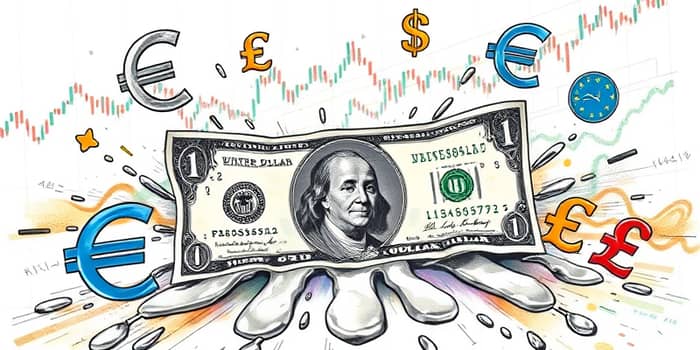
Market participants are witnessing a softening trend in global markets as the US dollar loses ground. Fed policy expectations and economic data have combined to reshape currency dynamics.
Over the past twelve months, the dollar has experienced one of its sharpest declines, confronting both traders and policymakers with fresh challenges and opportunities.
The US Dollar Index (DXY) closed at 97.3369 on June 27, 2025, marking a 2.54% fall this month and a substantial 8.04% slide over the last year. In a single session, the index rose 0.20%, but that only partially offsets the broader downward trajectory.
Against the euro, the dollar weakened from 0.9654 USD/EUR in January 2025 to 0.8697 USD/EUR by late June. At one point, €1 was valued at $1.1730, the strongest euro-to-dollar rate observed during the window.
The dollar’s retreat is rooted in expectations of a policy pivot by the Federal Reserve. After holding rates steady since January 2025, most traders now anticipate two additional 25 basis point cuts before year-end.
These developments suggest that US interest rates will remain lower for longer interest rates, reducing the yield advantage of dollar assets.
As the dollar falls, the cost of imports rises, potentially stoking domestic inflation. At the same time, US exporters find their goods increasingly competitive abroad.
Investment strategies must adapt to a backdrop where currency risk plays a more prominent role, and global rate differentials narrow.
While the Fed contemplates additional easing, other central banks have taken diverse approaches. The European Central Bank has signaled a more cautious stance, while some Asian economies tightened to combat inflation.
This divergence creates volatility in USD crosses. Currencies of countries maintaining or raising interest rates often benefit at the dollar’s expense, even as underlying growth slows worldwide.
For businesses and investors, understanding both the macro trend and tactical levers can unlock new opportunities. Consider the following guidelines:
By adopting proactive measures, market participants can embrace emerging market opportunities even amid uncertainty.
To keep critical metrics in view, the following table summarizes core data:
Analysts predict the DXY could climb back to around 99.60 by quarter-end and 101.06 within 12 months if economic conditions warrant a slower pace of cuts. However, if inflation continues to ease and growth softens further, the dollar may stay on the defensive.
Global political factors, from election outcomes to trade negotiations, will also influence capital flows and volatility. Maintaining flexibility and a broad perspective will be key for those seeking to thrive as the Fed recalibrates policy.
The US dollar’s softening amid steadily evolving policy expectations marks a pivotal moment for global finance. Whether you are an exporter, investor, or policymaker, staying informed and adaptable offers the best path forward.
In a world of interconnected economies, currency shifts create both challenges and avenues for growth. With thoughtful strategies and a long-term lens, participants can transform uncertainty into opportunity and chart a course through this dynamic environment.
References













